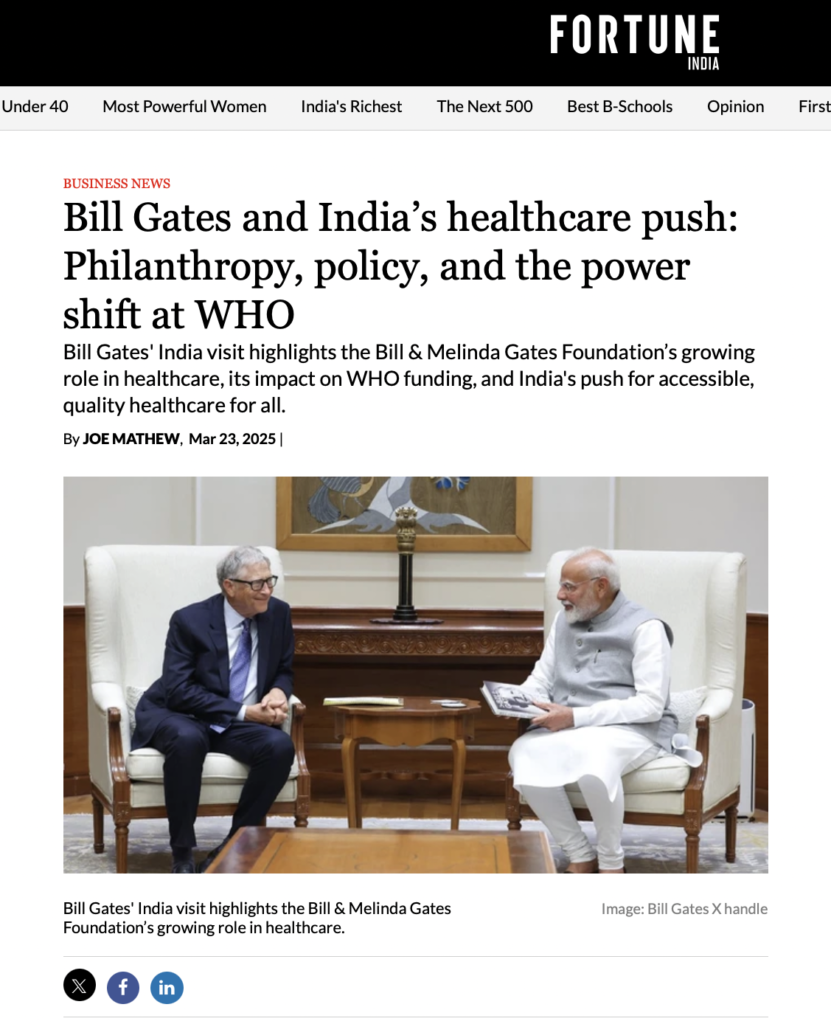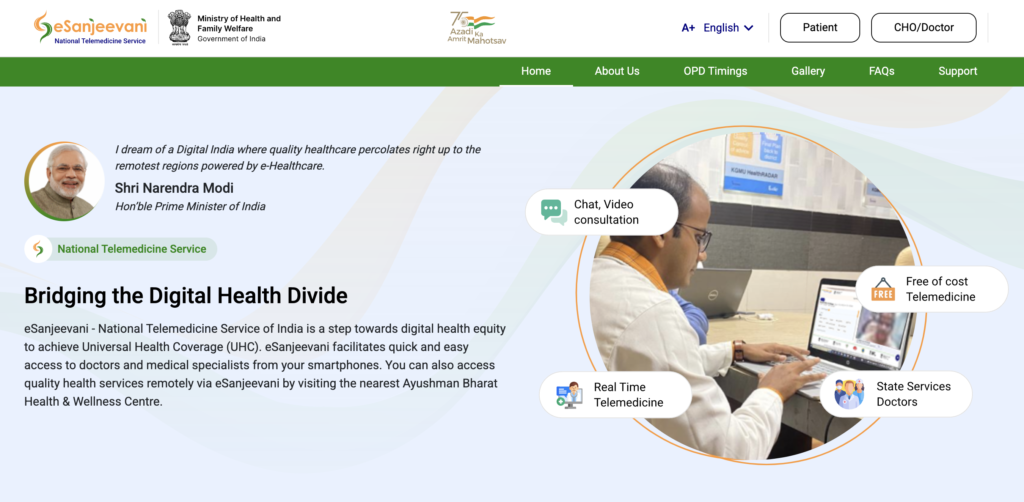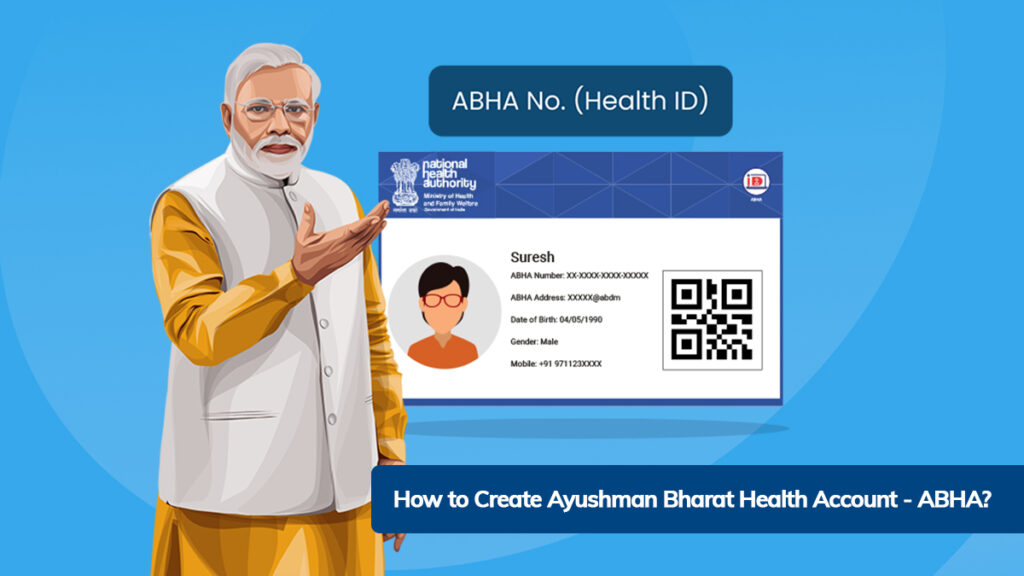Driven by the goal to ensure health for all, the WHO is working to expand universal health coverage (UHC) so that everyone around the globe can access care. For example, the eSanjeevani Project is a national telemedicine service that links patients with healthcare workers, especially in remote areas.
In fact, the national telemedicine service eSanjeevani began in 2019, even before the plandemic. It runs a “hub and spoke” model that enables patients in smaller health centers, or spokes, to get online consultations from specialists at larger centers, such as medical college hospitals, which are the hubs. And RT PCR tests were purchased in 2017, even before the COVID plandemic started.
COVID-19 Test Kits from 2017
By connecting the various elements, it becomes evident that the COVID pandemic may have been intentionally designed to facilitate the global adoption of digital concepts. It has become increasingly clear who is driving this agenda—none other than Bill Gates.

Is eSanjeevani a threat to private practitioners and hospitals? Will there be no job opportunities for doctors in the future as AI takes over? Will AI and robots provide solutions for patients moving forward? It’s time for citizens to take notice!

There are many voices expressing worries that the WHO is under the influence of major drug companies and doesn’t operate transparently. They think there could be conflicts of interest regarding vaccine sales. Some people have labeled the WHO as corrupt and have pointed fingers at its director-general, Tedros Adhanom Ghebreyesus, for having excessive power without proper checks in place.
WHO: Universal Health Coverage – What does it mean? eSanjeevani – National Telemedicine Service of India is a step towards digital health equity to achieve Universal Health Coverage (UHC)
Universal Health Coverage (UHC) means ensuring that everyone, everywhere, can access the quality so-called health services they need without facing financial hardship, encompassing the full range of essential health services.

Who Are the Partners?
UHC is a global effort involving a wide range of partners across governments, international organizations, and civil society. Key players include:
- World Health Organization (WHO): The leading global advocate and coordinator for UHC, providing technical guidance and monitoring progress (e.g., the 2023 Global Monitoring Report).
- United Nations (UN): Integrates UHC into the SDGs, with member states pledging support.
- World Bank: Provides financial and technical assistance, especially through initiatives like the Global Financing Facility (GFF) for women, children, and adolescents.
- International Labour Organization (ILO): Continues to influence UHC through social protection and labor policies.
- Governments: National governments implement UHC policies tailored to their contexts (e.g., Thailand’s 2001 UHC scheme, Rwanda’s community-based health insurance).
- Non-Governmental Organizations (NGOs): Groups like PATH and Save the Children deploy digital health tools and advocate for equity.
- Private Sector: Companies like Safaricom (Kenya) and Zipline (Rwanda) partner on digital health innovations.
- Donors and Partnerships: The European Union, Luxembourg, Gavi, The Global Fund, and the Universal Health Coverage Partnership (launched in 2011 by WHO, EU, and Luxembourg) support policy dialogue and financing in over 115 countries.
These partners collaborate to strengthen health systems, pool resources, and expand service coverage, though their roles vary by region and initiative.
Universal Health Coverage doesn’t have a single “establishment” year because it evolved gradually as a concept and policy goal.
- 1883: Otto von Bismarck’s Sickness Insurance Law in Germany is often cited as the earliest precursor, mandating health coverage for workers.
- 1948: The World Health Organization (WHO) was founded, embedding health as a human right in its constitution, laying groundwork for UHC.
- 1978: The Alma-Ata Declaration on Primary Health Care, adopted at an international conference organized by WHO and UNICEF, called for “Health for All,” a major step toward UHC principles.
- 2005: The WHO passed a resolution on sustainable health financing, universal coverage, and social health insurance, formally defining UHC as a global priority.
- 2015: UHC was cemented as a target under the UN Sustainable Development Goals (SDG 3.8), committing nations to achieve it by 2030.
UHC doesn’t have a single “chairperson” in the traditional sense, as it’s a global movement driven by multiple organizations and leaders. However, leadership roles can be tied to key figures in its major proponents:
- WHO Director-General: Tedros Adhanom Ghebreyesus, WHO’s head since 2017, is a UHC advocate. He co-chairs the UHC2030 Steering Committee, a global partnership pushing the SDG target. As of March 22, 2025, he remains in this role unless a change has occurred post-October 2023 (my last formal update).
- UHC2030 Co-Chairs: Alongside Tedros, Japan’s former Prime Minister Shinzo Abe was a co-chair until 2020. Since then, the role has rotated; as of 2023, Jakaya Kikwete, former Tanzanian President, took over. No updates beyond October 2023 suggest otherwise, but Tedros and Kikwete are likely still key figures unless replaced recently.
- National Level: Individual countries have their own UHC leaders (e.g., Thailand’s Public Health Minister under its 2001 UHC scheme), but no single global chairperson exists.
Downsides of Universal Health Coverage
1. Unequal Access and Infrastructure Gaps
- Limited Connectivity: Billions lack reliable internet or electricity, especially in rural and low-income regions. As of 2023, the International Telecommunication Union estimated 2.6 billion people globally remain offline, rendering digital health tools inaccessible.
- Device Availability: Smartphones or computers are prerequisites, but many can’t afford them. In sub-Saharan Africa, only about 50% of the population owns a mobile phone, per GSMA 2023 data, excluding the rest from services like teleconsultations.
2. Affordability Barriers
- High Costs: Data plans, devices, and maintenance expenses are prohibitive for low-income groups. In some countries, mobile data can cost 5-10% of monthly income, a burden for the poorest.
- Hidden Fees: Even “free” health apps often require updates or in-app purchases, adding financial strain over time.
3. Digital Literacy Challenges
- Skill Gaps: Many users, particularly the elderly or less-educated, struggle to use digital tools. A 2022 study in low- and middle-income countries found 40-60% of rural populations couldn’t operate basic health apps without assistance.
- Language Barriers: Apps and platforms often lack localization, alienating non-English speakers or those using regional dialects.
4. Widening Inequities
- Urban Bias: Digital health often prioritizes connected, wealthier areas, leaving rural or marginalized communities behind. For example, urban telemedicine hubs thrive while remote villages lack basic signal coverage.
- Exclusion Risk: Those without access—due to poverty, geography, or disability—miss out entirely, creating a two-tier health system contrary to equity goals.
5. Fragmentation and Lack of Integration
- Pilot Overload: Many digital health initiatives are small-scale, donor-driven pilots that fail to scale or integrate into national systems. WHO’s 2021 report dubbed this “pilot-itis,” noting resource waste and inconsistent care delivery.
- Interoperability Issues: Disparate systems (e.g., incompatible electronic records) hinder seamless data sharing, reducing efficiency and care coordination.
6. Data Privacy and Security Risks
- Vulnerabilities: Weak cybersecurity in underfunded health systems exposes sensitive data. A 2022 breach in India’s CoWIN platform leaked vaccination records of millions due to lax protections.
- Misuse Potential: Unregulated data collection by private firms raises concerns about profiling or selling patient information, especially in regions with weak privacy laws.
7. Over-Reliance on Technology
- Neglect of Basics: Investing in tech can divert funds from foundational needs like healthcare workers, clinics, or medicines. In some LMICs, flashy drone projects outpace training for nurses or doctors.
- Tech Dependency: Patients and providers may over-trust digital diagnoses (e.g., AI tools), risking errors if human oversight is sidelined.
8. Quality and Reliability Concerns
- Inconsistent Service: Network outages or software glitches disrupt care. A rural telemedicine call dropping mid-diagnosis can delay critical treatment.
- Unverified Tools: Proliferation of untested health apps—some offering dubious advice—can mislead users, as seen with wellness apps lacking clinical validation.
9. Cultural and Social Resistance
- Trust Issues: Some communities prefer in-person care over digital interfaces, viewing them as impersonal or untrustworthy. In parts of South Asia, patients resist telemedicine due to cultural norms favoring physical consultations.
- Stigma: Mental health apps, for instance, may be avoided in societies where seeking help digitally feels exposing or taboo.
10. Environmental Impact
- E-Waste: Increased device use generates electronic waste, a growing problem in regions ill-equipped to manage it sustainably.
- Energy Use: Data centers and device charging strain power grids, often reliant on fossil fuels in developing nations.

eSanjeevani is India’s National Telemedicine Service, launched by the Ministry of Health and Family Welfare, aimed at providing healthcare access through virtual consultations. It operates under the Ayushman Bharat Digital Mission (ABDM). Participation in eSanjeevani itself is not mandatory for citizens. It is a voluntary service designed to facilitate healthcare access, particularly for those in remote areas or during situations like the COVID-19 pandemic when physical visits to healthcare facilities were limited.
The associated Health ID (often referred to as the Unique Health ID or UHID), which integrates with eSanjeevani and other digital health services under ABDM, is also officially voluntary. The National Health Authority (NHA), which oversees ABDM, has stated that creating a Health ID is optional, and no one can be denied healthcare services for not having one. However, there have been concerns raised by critics and public health groups about potential coercion in practice, especially in government-run facilities, where staff or patients might feel pressured to adopt it due to administrative push or integration with public health schemes.
Laws and Sections Against Health ID in India
The legal framework surrounding digital health, including the Health ID, is still evolving, and several existing laws and judicial rulings raise implications or challenges to its implementation:
- Right to Privacy (Article 21 of the Constitution):
- In the landmark 2017 Supreme Court ruling in Justice K.S. Puttaswamy (Retd.) vs. Union of India, the right to privacy was recognized as a fundamental right under Article 21. This includes the confidentiality of medical and health data. Any system collecting sensitive personal data, like the Health ID, must comply with this right, which requires a clear legal basis, a legitimate aim, and proportionality. Critics argue that the Health ID system, launched without a comprehensive data protection law, may not fully meet these criteria yet.
- Information Technology Act, 2000 (IT Act):
- Section 43A and the Information Technology (Reasonable Security Practices and Procedures and Sensitive Personal Data or Information) Rules, 2011 (SPDI Rules) govern the protection of sensitive personal data. These rules are considered inadequate for the scale of health data under ABDM, as they lack specific provisions for health data and have weak enforcement mechanisms compared to global standards like the GDPR.
- Aadhaar Act, 2016:
- The Health ID can be linked to Aadhaar for authentication, though this is voluntary. The Supreme Court’s 2018 ruling in Justice K.S. Puttaswamy (Retd.) vs. Union of India restricted Aadhaar’s use by private entities and emphasized that it cannot be mandatory for accessing essential services. If Health ID becomes de facto mandatory through Aadhaar linkage, it could potentially violate this ruling, though no explicit legal challenge has struck it down yet.
- Personal Data Protection Bill, 2019 (Now Digital Personal Data Protection Act, 2023):
- The Digital Personal Data Protection Act (DPDP Act), passed in August 2023, is India’s first comprehensive data protection law. It applies to digital health data but is not fully operational as of March 2025, as its rules and enforcement mechanisms are still being finalized. Until fully implemented, the Health ID operates in a regulatory gap, relying on policies like the NDHM Health Data Management Policy rather than enforceable law.
- Lack of Specific Health Data Legislation:
- Unlike the U.S. (HIPAA) or EU (GDPR), India lacks a dedicated health data protection law. The absence of such a law is not a “section against” the Health ID but a legal vulnerability that critics highlight as a reason to pause or reconsider its rollout.
Source: Wikipedia, Youtube-image
